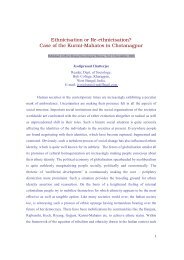Chapter 5 - WebRing
Chapter 5 - WebRing
Chapter 5 - WebRing
Create successful ePaper yourself
Turn your PDF publications into a flip-book with our unique Google optimized e-Paper software.
CHAPTER 5. MAGNETIC SYSTEMS 265<br />
m<br />
1.0<br />
0.5<br />
0.0<br />
–0.5<br />
T < T c<br />
T = T c<br />
T > T c<br />
–1.0<br />
–2.0 –1.0 0.0 1.0 2.0<br />
H<br />
Figure 5.15: The equilibrium values of m as a function of the magnetic field H for T > Tc, T = Tc,<br />
and T < Tc. The plot for T > Tc is smooth in contrast to the plot for T < Tc which has a<br />
discontinuity at H = 0. For T = Tc there is no discontinuity, and the function m(H) has an<br />
infinite slope at H = 0.<br />
characteristic of discontinuous phase transitions. An example of the data you can obtain in<br />
this way is shown in Figure 5.16.<br />
(d) Change the number of mcs per field value to 1 and view the resulting plot for m versus H.<br />
Repeat for mcs per field value equal to 100. Explain the differences you see.<br />
5.8 *Simulation of the Density of States<br />
The probability that a system in equilibrium with a heat bath at a temperature T has energy E<br />
is given by<br />
P(E) = Ω(E)<br />
Z e−βE , (5.129)<br />
whereΩ(E)isthenumberofstateswithenergyE, 11 andthepartitionfunctionZ = <br />
EΩ(E)e−βE .<br />
If Ω(E) is known, we can calculate the mean energy (and other thermodynamic quantities) at any<br />
temperature from the relation<br />
E = 1<br />
Z<br />
<br />
EΩ(E)e −βE . (5.130)<br />
E<br />
Hence, the quantityΩ(E) is of much interest. In the followingwe discuss an algorithmthat directly<br />
computes Ω(E) for the Ising model. In this case the energy is a discrete variable and hence the<br />
quantity we wish to compute is the number of spin microstates with the same energy.<br />
11 The quantity Ω(E) is the number of states with energy E for a system such as the Ising model which has discrete<br />
values of the energy. It is common to refer to Ω(E) as the density of states even when the values of E are discrete.

















